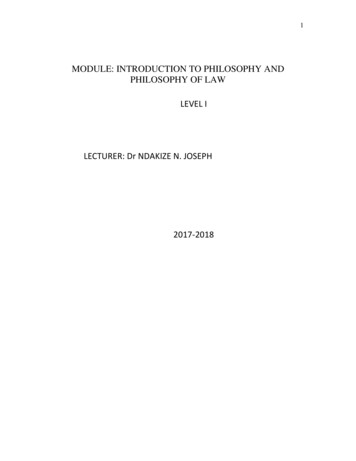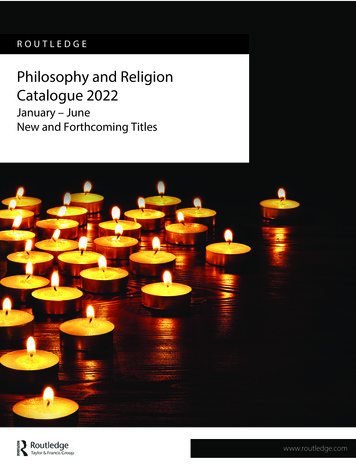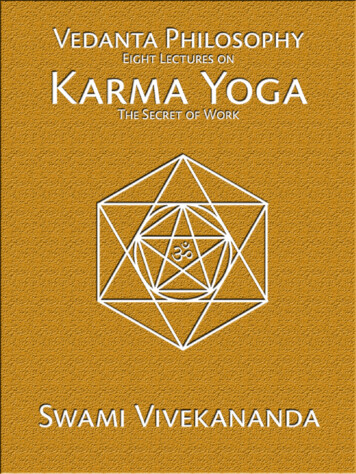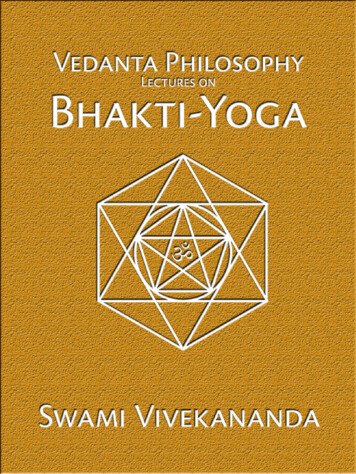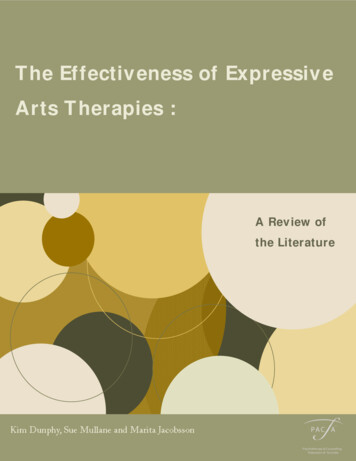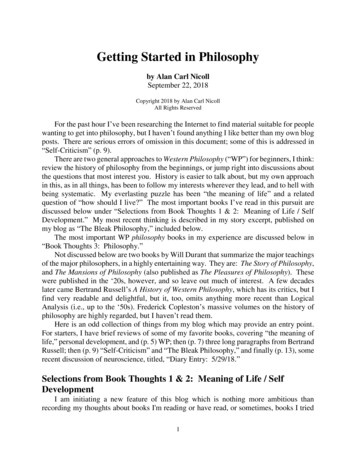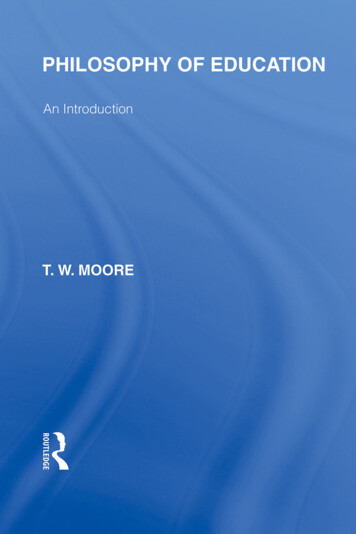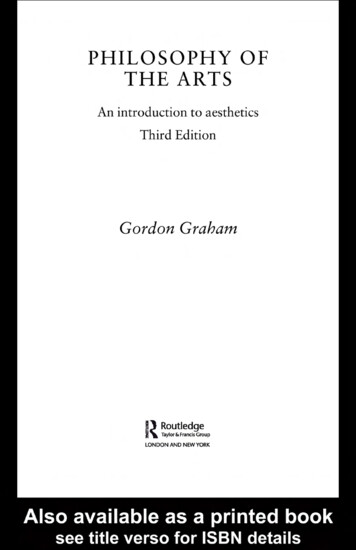
Transcription
PHILOSOPHY OF THE ARTS‘The new edition of Philosophy of The Arts provides one of the mostcomprehensive and pellucid introductions to aesthetics on the market.’Andy Hamilton, Durham University, UKPhilosophy of The Arts presents a comprehensive and accessible introduction to those coming to aesthetics and the philosophy of art for the first time.The third edition is greatly enhanced by new chapters on art and beauty, theperforming arts and modern art, and new sections on Aristotle, Hegel andNietzsche. All other chapters have been thoroughly revised and extended.This new edition: is jargon-free and will appeal to students of music, art history, literatureand theatre studies as well as philosophylooks at a wide range of the arts from film, painting and architecture toliterature, music, dance and dramadiscusses the philosophical theories of major thinkers including Aristotle,Hume, Hegel, Nietzsche, Croce, Collingwood, Gadamer and Derridaincludes regular summaries and suggestions for further reading.Gordon Graham is Henry Luce III Professor of Philosophy and the Arts atPrinceton Theological Seminary. He was formerly Regius Professor ofMoral Philosophy at the University of Aberdeen in Scotland. He is theauthor of Eight Theories of Ethics and The Internet: A PhilosophicalInquiry, both published by Routledge.
PHILOSOPHY OFTHE ARTSAn introduction to aestheticsThird EditionGordon Graham
First published 1997Second edition published 2000Third edition published 2005by Routledge2 Park Square, Milton Park, Abingdon, Oxon, OX14 4RNSimultaneously published in the USA and Canadaby Routledge270 Madison Ave, New York, NY 10016Routledge is an imprint of the Taylor & Francis GroupThis edition published in the Taylor & Francis e-Library, 2005.“To purchase your own copy of this or any of Taylor & Francis or Routledge’scollection of thousands of eBooks please go to www.eBookstore.tandf.co.uk.” 1997, 2000, 2005 Gordon GrahamAll rights reserved. No part of this book may be reprinted orreproduced or utilized in any form or by any electronic,mechanical, or other means, now known or hereafterinvented, including photocopying and recording, or in anyinformation storage or retrieval system, without permission inwriting from the publishers.British Library Cataloguing in Publication DataA catalogue record for this book is available from theBritish LibraryLibrary of Congress Cataloging in Publication DataGraham, Gordon, 1949 July 15–Philosophy of the arts: an introduction to aesthetics/GordonGraham.—3rd ed.p. cm.Includes bibliographical references and index.1. Aesthetics. I. Title.BH39.G67 2005111′.85—dc222005002568ISBN 0-203-69622-0 Master e-book ISBNISBN 0–415–34978–8 (hbk)ISBN 0–415–34979–6 (pbk)
In memory ofChristina Marie Kennedy (1974–97)to whom these questions mattered
Contents Preface to the Third Edition xiIntroduction 11 ART AND PLEASURE 3Hume on taste and tragedy 3Collingwood on art as amusement 6Mill on higher and lower pleasures 8The nature of pleasure 122ART AND BEAUTY 14Beauty and pleasure 14Kant on beauty 16The aesthetic attitude and the sublime 19Art and the aesthetic 21Gadamer and art as play 23Art and sport 26Summary 293 ART AND EMOTION 31Tolstoy and everyday expressivism 31Aristotle and katharsis 35Expression and imagination 37Croce and ‘intuition’ 38Collingwood’s expressivism 41Expression vs expressiveness 44Summary 504ART AND UNDERSTANDING 52Hegel, art and mind 52Art, science and knowledge 54Aesthetic cognitivism, for and against 58Imagination and experience 62vii
CONTENTSThe objects of imagination 65Art and the world 68Understanding as a norm 70Art and human nature 73Summary 745MUSIC AND SONIC ART 76Music and pleasure 76Music and emotion 79Music as language 83Music and representation 86Musical vocabulary and musical grammar 88Résumé 92The uniqueness of music 92Music and beauty 93Music as the exploration of sound 95Sonic art and digital technology 97Summary 1016 THE VISUAL ARTS 103What is representation? 104Representation and artistic value 105Art and the visual 108Visual art and the non-visual 113Film as art 116Montage vs long shot 118‘Talkies’ 120The ‘auteur’ in film 123Summary 1267THE LITERARY ARTS 127Poetry and prose 127The unity of form and content 130Figures of speech 132Expressive language 134Poetic devices 135Narrative and fiction 140Literature and understanding 145Summary 1478 THE PERFORMING ARTS 149Artist, audience and performer 149Painting as the paradigm of art 150Nietzsche and The Birth of Tragedy 154viii
CONTENTSPerformance and participation 157The art of the actor 160Summary 1629ARCHITECTURE AS AN ART 164The peculiarities of architecture 165Form, function and ‘the decorated shed’ 169Façade, deception and the ‘Zeitgeist’ 171Functionalism 174Formalism and ‘space’ 175Résumé 178Architectural expression 178Architecture and understanding 180Summary 18110 MODERN ART 183The break with tradition 183Experimental art and the avant-garde 185The art of the readymade 188Conceptual art 191The market in art 193Art and leisure 195Summary 19811THE AESTHETICS OF NATURE 200Objectivism vs subjectivism 200Art and interpretation 203The artist’s intention and the ‘intentional fallacy’ 207The aesthetics of nature 213Summary 21812THEORIES OF ART 221Defining art 221Art as an institution 228Marxism and the sociology of art 230Lévi-Strauss and structuralism 235Derrida, deconstruction and postmodernism 238Normative theory of art 243Summary 248Finding examples 251Bibliography 252Index 257ix
Preface to the Third Edition The first edition of Philosophy of The Arts appeared in 1997, with a secondrevised edition appearing in 2000. From the start I have had the benefit of alarge number of comments from teachers, students, readers and reviewers.The publisher’s suggestion of a third edition has now allowed me to takeaccount of most of them, but the list of people to whom I owe a debt hasgrown too long to detail. Continued thanks are due to staff at Routledge,who have promoted the book with both enthusiasm and success.This third edition is a more major revision than the second. It includesa further two new chapters – Chapters 8 and 11 – and what was Chapter 1in both previous editions has been split into two to allow the material onKant to be expanded. All the other chapters have been rewritten, and newmaterial added to most of them.Early versions of some of the themes I discuss were published in papersin the British Journal of Aesthetics, the Journal of Aesthetic Education, theJournal of Aesthetics and Art Criticism, the Journal of Value Inquiry, Endsand Means, the Oxford Handbook of Aesthetics and the Routledge Companion to Aesthetics. All of the material I have used from these papers hasbeen extensively rewritten.Gordon GrahamKing’s College, AberdeenOctober 2004xi
Introduction The arts are an important part of human life and culture. They attract alarge measure of attention and support from states, commercial companiesand the public at large. But what makes something ‘art’, and why should wevalue it? These are practical questions for civil servants, charitable trusts,private sponsors and educational establishments. They are also theoreticalquestions with which philosophers have been concerned for more than2,000 years. Over that long period a number of important answers havebeen developed and explored, and the purpose of this book is to introducenewcomers to the field of aesthetics and art theory to both the problemsand their resolution. Philosophy of art is simply an attempt to answer thesequestions in a sustained and coherent way, while drawing upon the thinkingof the major philosophers who have devoted most attention to them. Myintention, however, is not just to provide a textbook for students of philosophy. The book also aims to demonstrate to anyone who reads it – studentor non-student – that philosophy of art (or aesthetics) is directly relevant tothe study, appreciation and practice of the arts.Philosophers are not the only people to develop theories of art. Sociologists, musicologists, art critics and literary theorists have done so as well. Butwhat philosophy has to say on these topics is especially relevant to any seriousthinking about the value and importance of art. At the same time, it becomeslifelessly abstract if it is too far removed from the arts themselves. That iswhy, after four chapters on general themes, the book divides into chaptersexpressly devoted to particular art forms including, for the first time in thisedition, the performing arts. The idea is to stimulate an interest in philosophyamong those whose principal motivation for approaching these topics is alove of music, painting, film, literature, drama, dance or architecture. Chapter 10 considers at length some recent developments, especially in the plasticarts, and addresses a common concern about modern art – is it art at all? –while Chapter 11 investigates the topical subject of environmental aesthetics.The final chapter of the book explores more complex issues of art theory and,in particular, the Marxist, structuralist and postmodern approaches to art.One special difficulty about focusing on the specific rather than the general1
INTRODUCTIONis this: we can only talk meaningfully about paintings, poems, symphonies,and so on if, quite literally, we know what we are talking about. This meansthat the reader needs to be familiar with the illustrative examples, and it isimpossible to be sure of this in advance. So far as I can, I have used the verybest-known examples of artworks – for example, the Mona Lisa, Beethoven’sNinth Symphony, Charles Dickens’s Bleak House, etc. – but sometimes lesswell-known examples illustrate the point at issue better. Happily, this difficulty is much less great than it was with the first edition because of theinternet, which has become a hugely valuable resource for this purpose.In addition to a complete bibliography, there is a list of websites wherecollections of artworks, including music, will be found.Suggestions for further reading have also been reorganized for this edition. At the end of each chapter I have identified more advanced introductory reading, classic writings and major contemporary studies. With one ortwo exceptions, the advanced introductory reading is taken from two booksthat have appeared since the first edition was published – the RoutledgeCompanion to Aesthetics (now in its second edition) and the Oxford Handbook of Aesthetics, both of which are accessible, comprehensive and authoritative. So far as is possible I have identified ‘classic’ writings from the past,but in a few cases included more recent works. All of them have been thefocus of widespread discussion. A third category aims to draw attention tomajor and important contemporary works, though inevitably this is a tinyselection out of all the available choices. The bibliography at the endincludes full details of all these publications, together with works cited inthe text. In addition it lists other books and articles that will be of interestto readers following up the topics of the different chapters.There are a good many introductions to the philosophy of art, and severalmore since the first edition of this one. The distinctive feature of mine is itsfocus on the value of art, and the exploration of normative issues in thecontext of specific art forms as well as the aesthetic appreciation of nature.This approach rests upon an assumption that it is better for the philosopherof art to investigate the question of art’s value than to try to arrive at adefinition of art, an assumption defended at length in the final chapter. I haveput this defence at the end of the book because, though it is logically priorand philosophically crucial to the cogency of my approach, a reader whoseinterest is primarily in matters artistic can usefully read the book up to thatpoint without going on to engage directly with the rather more abstractphilosophical issues involved in defending a normative approach.The third edition covers several topics that the first and second did not.Despite these additions, however, some interesting questions in aestheticshave inevitably been omitted. This is unavoidable because typically philosophy raises more questions than it answers. The point of an introductionis not to provide a definitive set of solutions to a designated set of problems,but to start the mind of the reader on an exploratory journey of its own.2
1 Art and pleasureThe most familiar question in philosophical aesthetics is this: what is art?Why is this question worth asking? The answer has to be that art matters.The question ‘what is art?’ is really the question ‘what counts as art?’ andwe want an answer to it in order to know whether or not something shouldbe accorded the status of art. In other words, a concern with what is art isnot just a matter of classification, but a matter of cultural esteem. Thereare, then, two fundamental issues in aesthetics – the essential nature of art,and its social importance (or lack of it). Philosophical aesthetics has tendedto focus on the first of these questions, almost exclusively in fact. But thereis a lot to be said for tackling the second question first. Accordingly, overthe course of the next few chapters we will examine four attempts to formulate a normative theory of art, which is to say, one that will explain itsvalue.What makes art valuable? A spontaneous answer, even to the point ofbeing commonplace, is this: art is a source of pleasure or enjoyment. Forthe sake of a label we could call this view ‘aesthetic hedonism’ from hedos,the Greek word for pleasure. The purpose of this chapter is to investigate theadequacy of aesthetic hedonism as a normative theory of art.Hume on taste and tragedySome philosophers have thought that the value of art is necessarily connected with pleasure or enjoyment because, they argue, to say that a painting, a poem, a play or a piece of music is good is just the same as sayingthat it pleases us. The best-known philosopher to hold this view was theeighteenth-century Scottish philosopher David Hume (1711–76). In a famous essay entitled ‘Of the Standard of Taste’ Hume argues that the importantthing about art is its ‘agreeableness’, the pleasure we derive from it, and thatthis is a matter of our sentiments, not its intrinsic nature. ‘Judgements’ aboutgood and bad in art, according to Hume, are not really judgements at all‘because sentiment has a reference to nothing beyond itself, and is always3
ART AND PLEASUREreal, wherever a man is conscious of it’ (Hume 1963: 238). In other words, ifI like a thing, I like it, irrespective of any characteristics it possesses. ‘To seekthe real beauty, or the real deformity, is as fruitless an enquiry, as to seek thereal sweet or real bitter’ (ibid. 239). That is to say, aesthetic preferences areexpressions of the taste of the observer, not statements about the object, andHume thinks the wide diversity of opinions about art that we find in theworld is confirmation of this fact.Here we touch upon a question that many people think is central to thephilosophy of art – can there be objective judgements of aesthetic value?Hume’s essay is widely taken to be the classic exposition and defence of viewthat they cannot be, that aesthetic opinions are essentially subjective. However, the main discussion of this issue will be postponed to a later stage(Chapter 10), because for the moment we are concerned not with the suggestion that aesthetic appraisals are subjective, but with the idea that, by theirvery nature, they are connected with pleasure.As a defence of subjectivism in aesthetics, though, Hume’s essay is notreally very persuasive. While he observes that aesthetic opinions can differgreatly, he also recognizes that at least some artistic sentiments can be sowide of the mark as to be discountable. If aesthetic appraisal is a matter offeeling, it seems there can be aberrant feelings. The case he considers is thatof a minor writer being compared with John Milton, the great poetic geniuswho wrote Paradise Lost. Though, says Hume, ‘there may be found personswho give the preference to the former . . . no one pays attention to such ataste; and we pronounce without scruple the sentiment of these pretendedcritics to be absurd and ridiculous’. What this implies is that, even thoughtaste is a matter of feeling things to be agreeable or disagreeable, there is stilla standard of taste, and the question is how these two ideas can be madeconsistent.Hume’s answer is that the standard of taste arises from the nature ofhuman beings. Since they share a common nature, broadly speaking theylike the same things. When it comes to art, he thinks, ‘[s]ome particularforms or qualities, from the original structure of the internal fabric [of thehuman mind], are calculated to please, and others to displease’ (1963: 271).There are of course strange reactions and opinions; people can prefer theoddest things. But Hume believes that the test of time will eventually tell,and that only those things which truly are aesthetically pleasing will go oncalling forth approbation as the years pass.On the face of it, Hume’s theory seems to fit the facts. Artistic tastes dodiffer greatly, yet broadly speaking, most people like and admire the samegreat masterpieces in music, painting, literature or architecture. Still, contrary to Hume’s suggestion, this shared tendency on the part of the majorityof people merely reveals a common taste, it does not validate any standardof taste. The fact that a feeling is shared by many people does not make itrationally obligatory for everyone to feel the same. If an individual has4
ART AND PLEASUREextremely peculiar musical tastes, say, we can certainly regard them as odd,but if Hume is right in thinking that aesthetics is all a matter of feeling, wehave no good reason to call them ‘absurd and ridiculous’; they are merelydifferent. If we want to say that some views about art are mistaken, wecannot make the mistake rest on human feeling about art – it just is what it is– but on something about the art itself.For present purposes, however, Hume’s contention about feeling as thebasis of aesthetic judgement is not the main issue, which is rather the connection he alleges between aesthetics and pleasure. Suppose it is true thatpeople declare artworks and performances to be good or bad in accordancewith the feeling those works prompt in them. It does not follow that thefeeling has to be one of pleasure. Hume, along with most of his contemporaries, believed that only pleasure could explain the power of art to attractand hold us. This is why, in another famous essay entitled ‘Of Tragedy’, hefinds it puzzling that people should willingly watch plays, read poems andview paintings that include events which would normally horrify them. Hisexplanation of this phenomenon is that though the horribleness of the eventswould naturally repel us, it is overlaid with (or even turned into) pleasure bythe artistry with which the events are depicted.[T]his extraordinary effect proceeds from that very eloquence withwhich the melancholy scene is depicted. The genius required to paintobjects in a lively manner, the art employed in collecting all the pathetic circumstances, the judgement displayed in disposing them; theexercise, I say, together with the force of expression and beauty oforatorial numbers, diffuse the highest satisfaction on the audience andexcite the most delightful moments. By this means the uneasiness of themelancholy passions is not only overpowered and effaced by something stronger of an opposite kind, but the whole impulse of thosepassions is converted into pleasure.(Hume 1963: 224)But why is it puzzling that people are attracted by tragedy? The problemarises only because Hume assumes that people must be deriving pleasurefrom the depiction of horrible events. Perhaps, on the contrary, some peoplerelish unpleasant feeling. If so, and if it is on this ground that they commendtragedies, horror films and so on, then Hume is right to think that theiraesthetic appraisals reflect sentiment or feeling, but wrong to think that thefeeling in question is one of pleasure.It follows that the connection between art and pleasure is not a necessaryone; to say that a work of art is good or valuable on the strength of thefeelings it invokes in us, is not the same as saying that we find it enjoyable.Moreover, we might describe it in positive terms – gripping or compelling, forinstance – without implying that we derive pleasure from it; the loathsomecan exercise a powerful fascination.5
ART AND PLEASURENevertheless, though ‘good’ does not mean ‘pleasurable’, it still makessense to claim that art is to be valued chiefly because of the pleasure or enjoyment it gives. It is this, I think, rather than Hume’s thesis, that most peoplewho believe there is a connection between art and enjoyment mean to assert.Collingwood on art as amusementIs it true that art is principally valuable as a source of pleasure and enjoyment? It is worth noting that it is not always natural to speak of ‘enjoying’art. People quite easily say this of novels, plays, films and pieces of music,but less easily of paintings, sculptures and buildings. So even if it wereagreed that ‘enjoyment’ often explains the value of art, some further explanation of just what this might mean in the case of the plastic arts andarchitecture would be needed.But a more important difficulty is this. To say that art is something weenjoy, tells us next to nothing. People enjoy lots of things – their work, theirholidays, their food. When someone says he enjoys his work, we usually askwhat it is about the work that is enjoyable, and expect his answer to tell usabout what he finds of value in it. ‘Enjoyment’ does no more than signal thathe values it. In a similar fashion, the initial claim that art is a source ofenjoyment is not in itself informative. It simply leads on to the next question.What makes it enjoyable?It is often assumed (as Hume assumes) that the answer is obvious; thingsare enjoyable because they give us pleasure. Now the concept of ‘pleasure’also needs some clarification, because it can be used in such a general fashionthat it means little more than ‘enjoyment’ in the sense just described, inwhich case we are no further forward. But getting clear about the concept ofpleasure is not as easy as we might suppose. There is a tendency to conflate‘pleasure’ with ‘happiness’ as though they were synonymous, when they arenot, and another tendency to think of ‘pleasure’ as the psychological opposite of ‘pain’. Both these tendencies are to be found in the founders of philosophical utilitarianism, Jeremy Bentham (1748–1832) and John Stuart Mill(1806–73), and since utilitarian ideas have had such a powerful influence oncontemporary culture, these tendencies have become widespread.The sense of ‘pleasure’ we want to examine here is something like ‘entertainment value’. The value of art is that it offers us entertainment. This is athesis that the British philosopher R. G. Collingwood (1889–1943) discussesin The Principles of Art, one of the major works of aesthetics published inthe twentieth century and one to which we will have occasion to return in alater chapter. Collingwood calls the belief that the value of art lies in itsability to entertain us, ‘art as amusement’. While he is partly engaged in thetraditional task of philosophical aesthetics – namely defining what art is –his interest is a normative one. The purpose of his book is to arrive at a6
ART AND PLEASUREsatisfactory conception of ‘art proper’ or true art, as we might say, and whathe wants to show is that ‘art as amusement’ falls short of ‘art proper’.Confusing the two hides an important mistake.Collingwood does not mean to deny that there are people for whom thearts are a form of entertainment, and it may indeed be the case that, as amatter of fact, they genuinely find amusement in plays, novels, and so on.This is an important point to stress. To claim that ‘art as amusement’ fallsshort of ‘art proper’ does not require us to deny that the arts have recreational value and can entertain us. Collingwood’s contention is that if this isall we find there, we have missed the thing most worth finding. His analysisof the error in ‘art as amusement’ is both insightful and persuasive, but bestconsidered in connection with his own, positive theory of art which will beexamined in Chapter 3. At this point in the argument, it is sufficient toregister a doubt he raises about an important assumption at work. The thesisthat art is valuable for the pleasure or amusement we derive from it depends,crucially, on the truth of a factual claim – that we do indeed derive pleasurefrom it.Is this actually true? What is at issue here is not a matter of language orbelief, but a matter of experience. First, people readily use the language ofpleasure and enjoyment in connection with the arts, but it does not followthat the thing they experience is properly called ‘pleasure’. Second, for allsorts of reasons people will claim that they enjoy major novels, great masters, the music of the concert hall, and may make this claim quite sincerely.But what they choose to do is often a more convincing test of their realopinion than what they feel constrained to say. Once we shift our attentionto the choices they make, it is not at all obvious that most people find mostof what we call art pleasurable in any straightforward sense.Someone who wants to read simply for pleasure is far more likely tochoose a novel by John Grisham than by William Faulkner, though the label‘literature’ would be attached to the latter rather than the former. Romanticcomedy is a more obvious choice than art film for most people going to thecinema, just for pleasure. Channel hoppers wanting an evening’s entertainment at home are, by and large, more likely to stop at soap opera thanShakespeare. And who, apart from a very few, would prefer the art gallery tothe restaurant if what is in view is simply pleasure?Such preferences need not prevail universally for the general point to hold;great novels can also be diverting and amusing. But there is this further pointto be emphasized. People who, for the purposes of entertainment, choosesoap opera over Shakespeare or Grisham over Faulkner, are most unlikely toclaim that what they have chosen is artistically more valuable or significant.Probably, they will agree that Faulkner is a far more important writer thanGrisham. Even so, his novels provide a much less pleasurable way of passingthe time. In the same way ‘easy listening’ is preferable to Beethoven’s lateQuartets, because it is easy, not because it is greater art.7
ART AND PLEASUREThe fact that personal pleasure and artistic significance can be divorcedin this way lends support to Collingwood’s contention that the prevalenceof ‘art as amusement’ as the explanation of aesthetic value has distortedpeople’s ability to ask honestly just how much pleasure they derive from‘high’ art. Collingwood thinks that there is often a measure of self-deceptionin people’s attitudes, because there is often a conventional pressure toclaim to enjoy art. But if we are honest most of us will admit that theentertainment value of high art is quite low compared to other amusements.The masses of cinema goers and magazine readers cannot be elevatedby offering them . . . the aristocratic amusements of a past age. This iscalled bringing art to the people, but that is clap-trap; what is broughtis still amusement, very cleverly designed by a Shakespeare or a Purcellto please an Elizabethan or a Restoration audience, but now, for all itsgenius, far less amusing than Mickey Mouse or jazz, except to peoplelaboriously trained to enjoy it.(Collingwood 1938: 103)Collingwood’s judgement on (his) contemporary culture may soundharsh, but he draws our attention to a point of some substance. Forms ofentertainment have become more sophisticated over the centuries. Whatwould have amused the ‘yokels’ in the pit at Shakespeare’s Globe theatremust seem a very poor form of entertainment to a generation reared ontelevision programmes like Fawlty Towers, Friends and Blackadder. Theseare far funnier than the comic scenes in Twelfth Night or A MidsummerNight’s Dream, and it is only a dogmatic commitment to the belief that greatart gives great pleasure that could lead us to deny it.In any case, there is this further objection. Even if we were to agree,contrary to what has been said, that art can be relied upon to amuse, thiswould not give us any special reason to value or pursue it. There are manyother cheaper and less taxing forms of amusement – card games, picnics,crossword puzzles, computer games, for example. If simple pleasure is whatis at issue, on the surface at any rate, art is at best only a contender for value,and in all probability a rather weak one.Mill on higher and lower pleasuresThe argument of the preceding section called into question an alleged fact –that people generally derive pleasure from art. But suppose that they do.There is still an important difficulty to be overcome. Not all works of art areto be valued to the same extent. If the value of art did lie in the pleasure weget from it, how are we to discriminate between artworks that differ inquality? How could pleasure explain the difference between, for example,Bach’s B Minor Mass and Boccerini’s Minuet, Tolstoy’s War and Peace and8
ART AND PLEASUREGraham Green’s Brighton Rock, or a production by the Royal ShakespeareCompany and one by the local amateur dramatic association? If all of themgive pleasure, why should we rank some so much more highly than others?Some people feel tempted to reply that we shouldn’t. We ought to respectthe fact that different people enjoy different things, and not try to elevatesome personal preferences over others. In fact, this appeal to equality has ledcritics and teachers to abandon, not just the distinction
PHILOSOPHY OF THE ARTS ‘The new edition of Philosophy of The Arts provides one of the most comprehensive and pellucid introductions to aesthetics on the market.’ Andy Hamilton, Durham University, UK Philosophy of The Arts presents a comprehensive and accessible introduc- tion to those coming to aesthetics and
